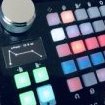-
Posts
1,703 -
Joined
-
Last visited
-
Days Won
86
Everything posted by PierM
-
It should work. I had one for couple of weeks (that I returned as imho was sounding awful). The audio you hear when it's booting it's the analog pass thru. Is it working with a standard cable? Are you using the original HX Stomp power supply? Also try with a mono adapter (female to male) as that TRS jack can create issues with the TS at the HX stomp input.
-
The Stomp is a "hot device" out of the box. It's an extremely tight package (it tends to overheat even in the studio) and over here, when it's hot summer, I use a 120mm fan to keep it in a safer range, that I've put under the pedalboard and powered with a 9V to 5V cheap converter. It helps moving a lot if air underneath and prevents the overheating. A sunshield is also recommended.
-
And after all these years I wonder...how difficult it can be for L6 to just add few extra lines/pages of text in that damn error screen to help the user in the process? I mean, even just a link would be better than that "boot failure. entered update mode!"
-
Unfortunately the main top lcd in the Helix Control board isnt the same type of screens used for the scribble strips. They could work around that limit implementing the option to switch to inverted pixel color to improve contrast.
-
This is a bit of a boomer statement. Alexa isnt sending any audio recording to anyone, unless you dont throw a command. Of course the system is "listening" to recognize when you use the trigger phrase, but that listening is just a local routine. If Alexa would send 24/7 an audio stream from any echo station running in the world, that would just blow up their servers. Also, you can force the system to not store any audio, which means all is happening is just a data roundtrip; trigger phrase, request sent to server, answer sent back to client, data deleted. It's 2023, soon AI will take over our daily jobs and govs already knows everything about us that needs to be known. Life is too short to live wearing a tinfoil hat. :)
-
You shouldnt browse presets in a gig. Use snapshots to create variations (seamless changes) within the same preset, or do your own presets setlist, with only presets you use, and balance them to work as you want. You can also place a volume block in each of them, to load at volume zero.
-
Sorry not going to open unknown hlx files, but check if that preset is using an iR block, with a missing iR file. This is a possible cause for noise because the amp block is hitting the output without a cab or an iR.
-
No, there is no way to prevent a preset being loaded, if you give the unit the time to load it. If this is annoying you that much (honestly never had a problem like that in 8 years of daily use), you can place a cheap volume pedal in front of the helix, and turn the volume down while browsing, or use PCs to call only the presets you want.
-

Uninstall Helix Native - Mac M1 Ventura 13.3.1 - HXN 3.60
PierM replied to furym's topic in Helix Native
Always do a full hard disk alias on your desktop, as this is a quick and easy way to access the entire disk. If you use the stock finder as is, it can be misleading.. :) -
As I said, I was wildly assuming. No complains or being negative. When I see no bug fixes for so many months/years, I start assuming the head programmers are busy and working on something else, while content guys are still there throwing goodies to keep the project alive, market wise. Again, just saying based on what I've seen with HD and Firehawk and any other similar product or software I've worked with. I'm happy with what I've, still, I'd rather have bugs and last gen OS drivers being released instead new stuff being added, but that's me - nobody cares really. :) All good, I'm still enjoying my HX with 3.15.
-
Everything that is based on the HX modeling technology.
-
I believe the HX project is coming to a end, so they are probably just scraping the yet available market's barrel offering more toys to trigger some residual attention. I wouldn't hold my breath on the "outstanding bugs" fixing on this phase. Probably there'll be a maintenance team later for this task. I mean, we are still waiting for compliant Win/Mac OS drivers... :) Just hardcore assumptions, but this always been the classic parabola of any other flagship Line 6 product.
-
Ok
- 9 replies
-
- 1
-

-
- helix rack
- freezes
-
(and 2 more)
Tagged with:
-
It may sounds tricky...but still better than iLok. Jeeeez...I once forgot to uninstall couple of eventide plugins from my old laptop before to trash it, and I almost had to write a begging letter to the Pope to get back that activation slot. Took more than a month to get the request approved. Viva L6!
-
I see. I'm not aware of any commands being sent at boot, and I remember I used my Helix with many loopers without any issues. Today I only own the Stomp, and as far as I can see, it's not sending any MIDI at boot, apart those commands stored in the presets. You could plug the Helix to a Midi event monitor and see what event is being sent at boot, if any.
-
Also, many cables and adapters from USB A to USB C are using a chip that needs to be discovered and allowed by MacOS prior any device connected to them. This means you have to unplug the Helix (and any other usb device) from those adapters each time you reboot the Mac, and re-plug after boot has completed.
-
Can't you just turn the Helix before the looper?
-
Zero issues with a MBP m1, running latest ventura.
-
Hi, this is just a community forum, with basically no interactions with the L6 guys. The right place for ideas is https://line6.ideascale.com
-
This envelope is ALREADY AVAILABLE inside the helix and used in all effects using the signal to drive an effect; Auto Wha. Auto Swells. Compressors, and many of those legacy effects that uses ECFs (Envelope-Controlled Filters). Calling it sensor just makes everything more confusing. Let's take the Helix auto wah blocks. How does it works? A bandpass filter let the guitar signal pass only at a specific peak threshold and then it attenuates its shape above and under this envelope. Then they use the envelope detector (which becomes a dynamic envelope follower) to produce a control voltage from the top end of the input, this CV signal is then used to dynamically sweep the cut-off frequency of the bandpass filter, emulating the behaviour of a wah pedal. Isntead of your foot, it's the envelope detector driving the filter. It's really easy to implememt. Line 6 just need to expose that same envelope for the user on the UI (imho the command area is the right place), and give the user the option to drive whatever parameter of any effect, using such envelope. Again, it's all there already.



